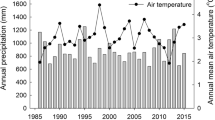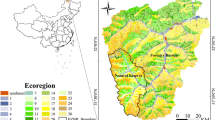Abstract
Scaling up ecosystem processes from plots to landscapes is essential for understanding landscape structure and functioning as well as for assessing ecological impacts of land use and climate change. This study illustrates an upscaling approach to studying the spatiotemporal pattern of ecosystem processes in the Changbai Mountain Nature Reserve in northeastern China by integrating simulation modeling, GIS, remote sensing data, and field-based observations. The ecosystem model incorporated processes of energy transfer, plant physiology, carbon dynamics, and water cycling. Using a direct extrapolation scheme, the patch-level ecosystem model was scaled up to quantify the landscape-level pattern of primary productivity and the carbon source-sink relationship. The simulated net primary productivity (NPP) for the entire landscape, consisting of several ecosystem types, was 0.680 kg C m−2 yr−1. The most widely distributed ecosystem type in this region was the mixed broad-leaved and Korean pine (Pinus koraiensis) forest, which had the highest NPP (1.084 kg C m−2 yr−1). The total annual NPP for all ecosystem types combined was estimated to be 1.332 Mt C yr−1. These results suggest that the Changbai Mountain landscape as a whole was a carbon sink, with a net carbon sequestration rate of about 0.884 Mt C yr−1 for the study period. The simulated NPP agreed reasonably well with available field measurements at a number of locations within the study landscape. Our study provides new insight into the relationship between landscape pattern and ecosystem processes, and useful information for improving management practices in the Changbai Mountain Nature Reserve, which is one of the most important forested landscapes in China. Several research needs are discussed to further refine the modeling approach and reduce prediction uncertainties.
Similar content being viewed by others
References
Aber JD, Burke IC, Acock B, Bugmann HKM, Kabat P, Menaut J-C, Noble IR, Reynolds JF, Steffen WL, Wu J (1999) Hydrological and biogeochemical processes in complex landscapes. In: Tenhunen JD, Kabat P (eds) Integrating hydrology, ecosystem dynamics, and biogeochemistry in complex landscapes. Wiley, Chichester, pp 335–355
Band L, Peterson D, Running S (1991) Forest ecosystem processes at the watershed scale: basis for distributed simulation. Ecol Model 56:171–196
Burke I, Schimel D, Yonker CM, Parton WJ, Joyce LA, Lauenroth WK (1990). Regional modeling of grassland biogeochemistry using GIS. Landscape Ecol 4:45–54
Chen BR, Xu GS, Ding GF, Zhang YH, Wang W (1984) Litterfall and nutrient contents of major forest ecosystems in Changbai Mountain. In: Changbai Mountain Forest Ecosystem Research Station (ed) Forest Ecosystem Study (IV). Chinese Forestry Press, Beijing, China, pp 19–22
Chen CG, Zhu JF (1989) Manual on biomass of main trees in northeastern China. Chinese Forestry Press, Beijing, China
Chen JM, Liu J, Cihlar J, Goulden ML (1999) Daily canopy photosynthesis model through temporal and spatial scaling for remote sensing applications. Ecol Model 124:99–119
Coughlan JC, Running SW (1997) Regional ecosystem simulation: a general model for simulating snow accumulation and melt in mountainous terrain. Landscape Ecol 12:119–136
Dai Y, Dickinson RE, Wang YP (2004) A two-big-leaf model for canopy temperature, photosynthesis, and stomatal conductance. Am Meteorol Soc 6:2281–2299
Ge JP, Guo HY, Chen D (1990) Study on population structure of natural Korean pine forests in Xiao Xinganling. J Northeast For Univ 18:26–32
Hong B, Swaney DP, Weinstein DA (2006) Simulting spatial nitrogen dynamics in a forested reference watershed, Hubbard Brook Watershed 6, New Hampshire, USA. Landscape Ecol 21:195–211
Jin CJ, Zhu T, Yang SH (1995) Study on the estimation of latent productivity in a broad-leaved Korean pine␣forest of Changbai Mountain. Acta Ecol Sin 15(Supp. B):86–92
Jin CJ, Guan DX, Zhu TY (2000) Spectral characteristics of solar radiation in broad-leaved Korean pine forest in Changbai Mountain. Chin J Appl Ecol 11:19–21
Kennedy RE, Turner DP, Cohen WB, Guzy M (2006) A method to efficiently apply a biogeochemical model to a landscape. Landscape Ecol 21:213–224
King AW (1991) Translating models across scales in the landscape. In: Turner MG, Gardner RH (eds) Quantitative methods in landscape ecology. Springer-Verlag, New York, pp 479–517
Law BE, Turner D, Campbell J, Lefsky M, Guzy M, Sun O, Tuyl SV (2006) Carbon fluxes across regions: observational constraints at multiple scales. In: Wu J, Jones KB, Li H, Loucks OL (eds) Scaling and uncertainty analysis in ecology: methods and applications. Springer, Dordrecht, The Netherlands, pp 167–190
Li H, Wu J (2006) Uncertainty analysis in ecological studies: an overview. In: Wu J, Jones KB, Li H, Loucks OL (eds) Scaling and uncertainty analysis in ecology: methods and applications. Springer, Dordrecht, The Netherlands, pp 45–66
Liu J, Chen JM, Cihlar J, Park WM (1997) A process-based boreal ecosystem productivity simulator using remote sensing inputs. Remote Sens. Environ 62:158–175
Liu J, Chen JM, Cihlar J, Chen W (1999) Net primary productivity distribution in the BOREAS region from a process model using satellite and surface data. J␣Geophys Res 104:27735–27754
Mladenoff DJ, Baker WL (1999) Spatial modeling of forest landscape change: approaches and applications. Cambridge University Press, New York
Norman JM (1982) Simulation of microclimates. In: Hatfield JL, Thomason IJ (eds) Biometeorology in integrated pest management. Academic Press, New York, pp 65–99
Parton WJ, Schimel DS, Cole CV, Ojima DS (1987) Analysis of factors controlling soil organic matter levels in Great Plains grasslands. Soil Sci Soc Am J 51:1173–1179
Pei TP, Sun JZ, Lu FY, Chi ZW (1981) Mathematic model for infiltration coefficient of forest soil. In: Changbai Mountain Forest Ecosystem Research Station (ed) Forest Ecosystem Study (II). Chinese Forestry Press, Beijing, China, pp 189
Running SW, Coughlan JC (1988) A general model of forest ecosystem processes for regional applications. I.␣Hydrologic balance, canopy gas exchange and␣primary production processes. Ecol Model 42:125–154
Running SW, Hunt ER (1993) Generalization of a forest ecosystem process model for other biomes, BIOME-BGC, and an application for global-scale models. In: Ehleringer JR, Field CB (eds) Scaling ecological processes: leaf to globe. Academic Press, San Diego, pp 141–158
Sun R, Chen JM, Zhu QJ, Zhou YY, Liu J, Li JT, Liu SH, Yan GJ, Tang SH (2004) Spatial distribution of net primary productivity and evapotranspiration in Changbaishan Natural Reserve, China, using Landsat ETM+ data. Can J Remote Sens 30:731–742
Turner MG, Gardner RH, O’Neill RV (2001) Landscape ecology in theory and practice: pattern and process. Springer-Verlag, New York
Turner MG, Cardille JA (2006) Spatial heterogeneity and ecosystem processes. In: Wu J, Hobbs R (eds) Key Topics in Landscape Ecology. Cambridge University Press, Cambridge, UK (in press)
Waring RH, Running SW (1998) Forest ecosystems: analysis at multiple scales. Academic Press, San Diego
Wu J, Levin SA (1994) A spatial patch dynamic modeling approach to pattern and process in an annual grassland. Ecol Monogr 64:447–464
Wu J, Loucks OL (1995) From balance-of-nature to hierarchical patch dynamics: a paradigm shift in ecology. Q Rev Biol 70:439–466
Wu J, Levin SA (1997) A patch-based spatial modeling approach: conceptual framework and simulation scheme. Ecol Model 101:325–346
Wu J (1999). Hierarchy and scaling: extrapolating information along a scaling ladder. Can J Remote Sens 25:367–380
Wu J, Hobbs R (2002) Key issues and research priorities in landscape ecology: an idiosyncratic synthesis. Landscape Ecol 17:355–365
Wu J, Jones KB, Li H, Loucks OL (2006) Scaling and uncertainty analysis in ecology: methods and applications. Springer, Dordrecht, The Netherlands
Wu J, Li H (2006) Perspectives and methods of scaling. In: Wu J, Jones KB, Li H, Loucks OL (eds) Scaling and uncertainty analysis in ecology: methods and applications. Springer, Dordrecht, The Netherlands, pp 17–44
Xing SP (1988) Forests of jilin province. Jilin Science and Technology Press, Changchun, Chinese Forestry Press, Beijing, China
Yan XD, Zhao SD (1995) CHANGFOR a computer model for forest growth and succession in Changbai Mountain. Acta Ecol Sin 15(Supp. B):86–92
Zhang N, Yu GR, Yu ZL, Zhao SD (2003a) Simulating leaf area index and biomass at the landscape scale. J␣Geogr Sci 13:139–152
Zhang N, Yu GR, Yu ZL, Zhao SD (2003b) Simulation of temporal and spatial distribution of natural vegetation light utilization efficiency based on 3S. Acta Phytoecol Sin 27:325–336
Zhang N, Yu GR, Yu ZL, Zhao SD (2003c) Analysis of factors affecting the spatial distribution of net primary productivity in the Changbai Mountain using a process model. Chin J Appl Ecol 14:659–664
Zhang N, Yu GR, Zhao SD, Yu ZL (2003d) Landscape-scale ecosystem productivity modeling using remote sensing and land surface data. Chin J Appl Ecol 14:643–652
Acknowledgements
We are grateful to Renchang Bu for providing digital maps of vegetation, soil, and elevation, Zengxiang Zhang and Mingliang Liu for Landsat TM images, and the Changbai Mountain Forest Ecosystem Research Station of the Chinese Academy of Sciences for meteorological data. Jone Liu and Jinming Chen graciously helped with the code of BEPS. We thank three anonymous reviewers for their helpful comments on the manuscript, and Xiaodong Yan, Xuyong Li, Bin Shao, and Baowen Chen for helpful discussions on the study design. This research was supported by National Natural Science Foundation of China (NSFC) (30500076), Natural Science Fund for Distinguished Young Scholars (30225012), NSFC (39970613), and Knowledge Innovation Programs of the Chinese Academy of Sciences (KZCX3-SW-218).
Author information
Authors and Affiliations
Corresponding author
Rights and permissions
About this article
Cite this article
Zhang, N., Yu, Z., Yu, G. et al. Scaling up ecosystem productivity from patch to landscape: a case study of Changbai Mountain Nature Reserve, China. Landscape Ecol 22, 303–315 (2007). https://doi.org/10.1007/s10980-006-9027-9
Received:
Accepted:
Published:
Issue Date:
DOI: https://doi.org/10.1007/s10980-006-9027-9




